实例介绍
【实例简介】Signal and Power Integrity-Simplified Second Edition(Eric Bogatin)
【实例截图】


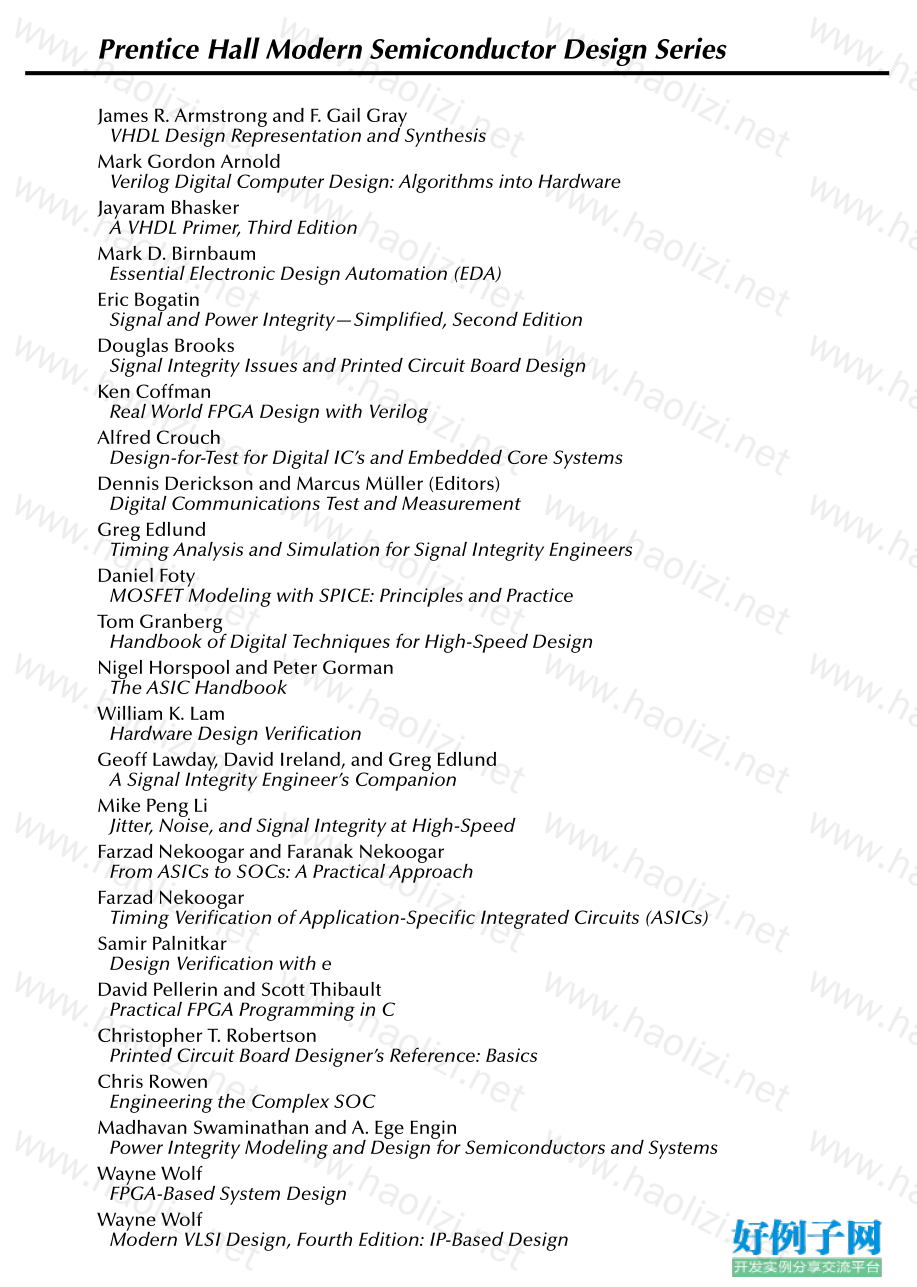

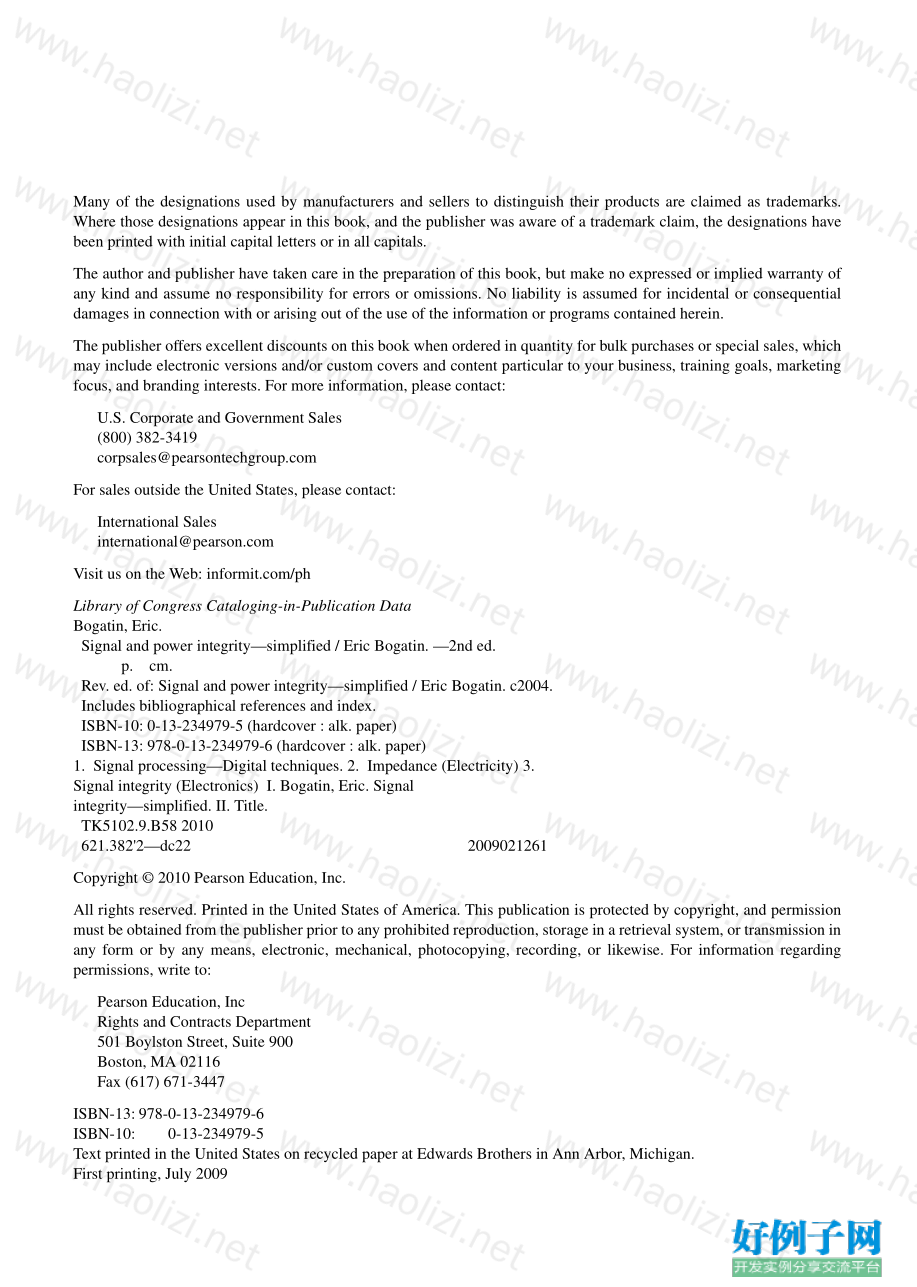
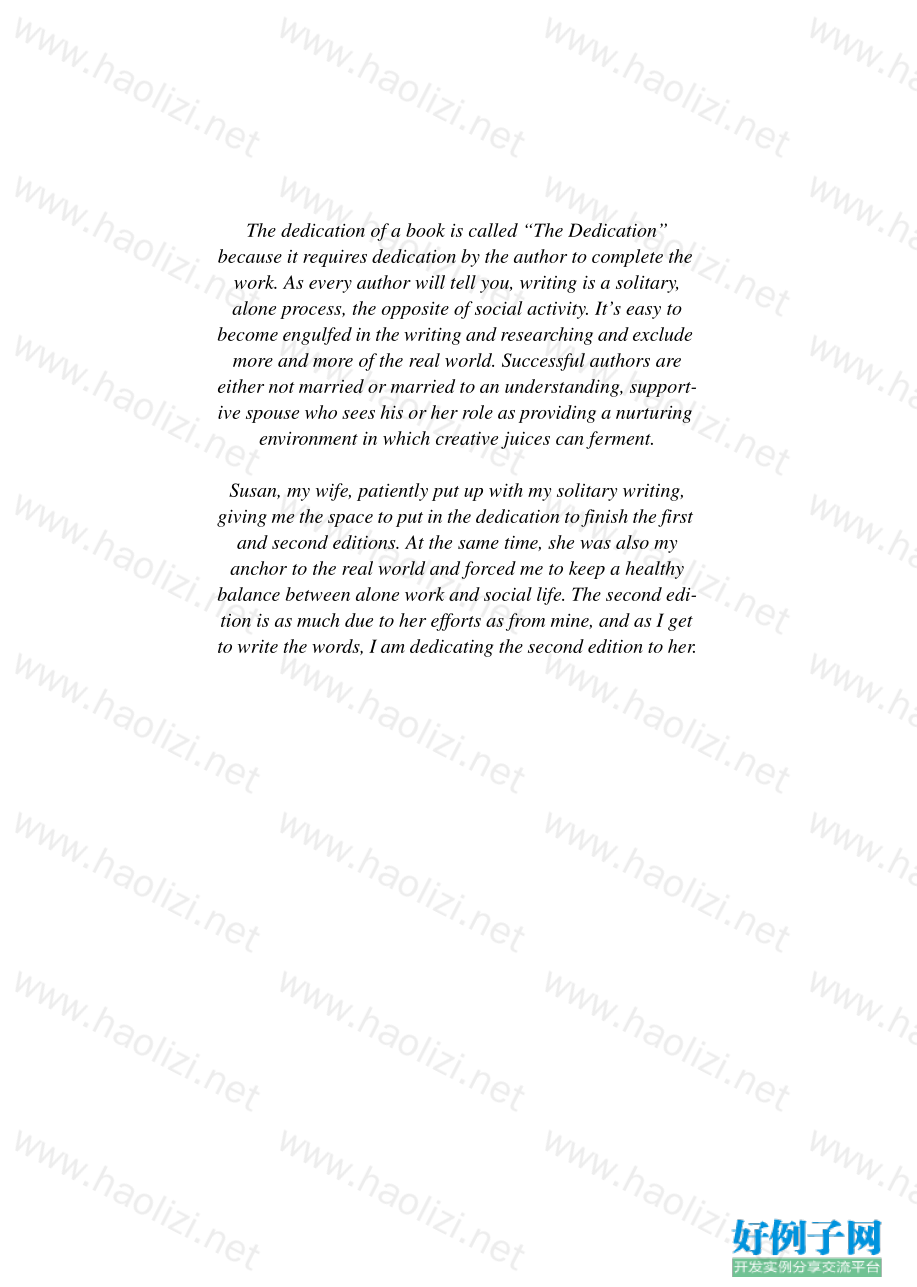
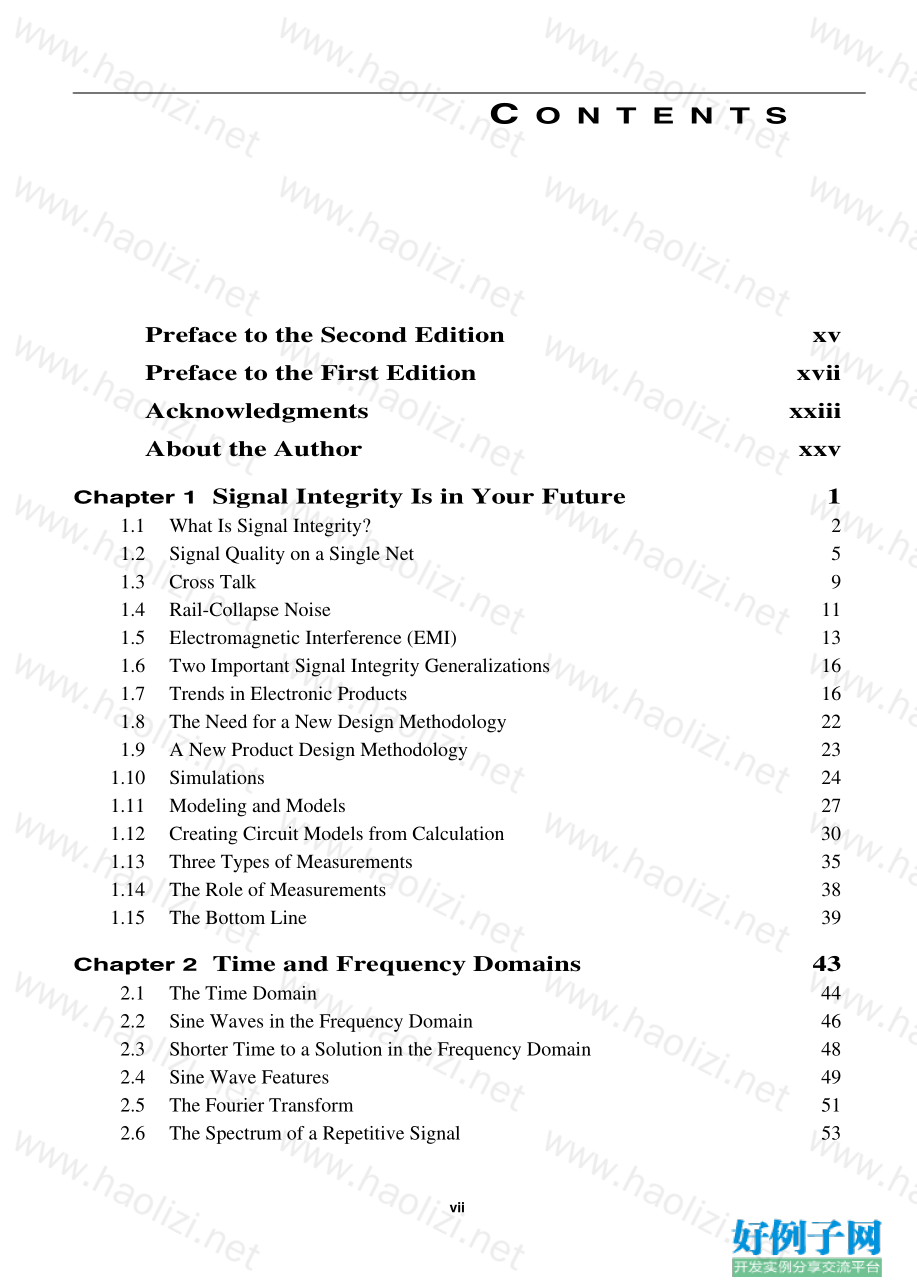
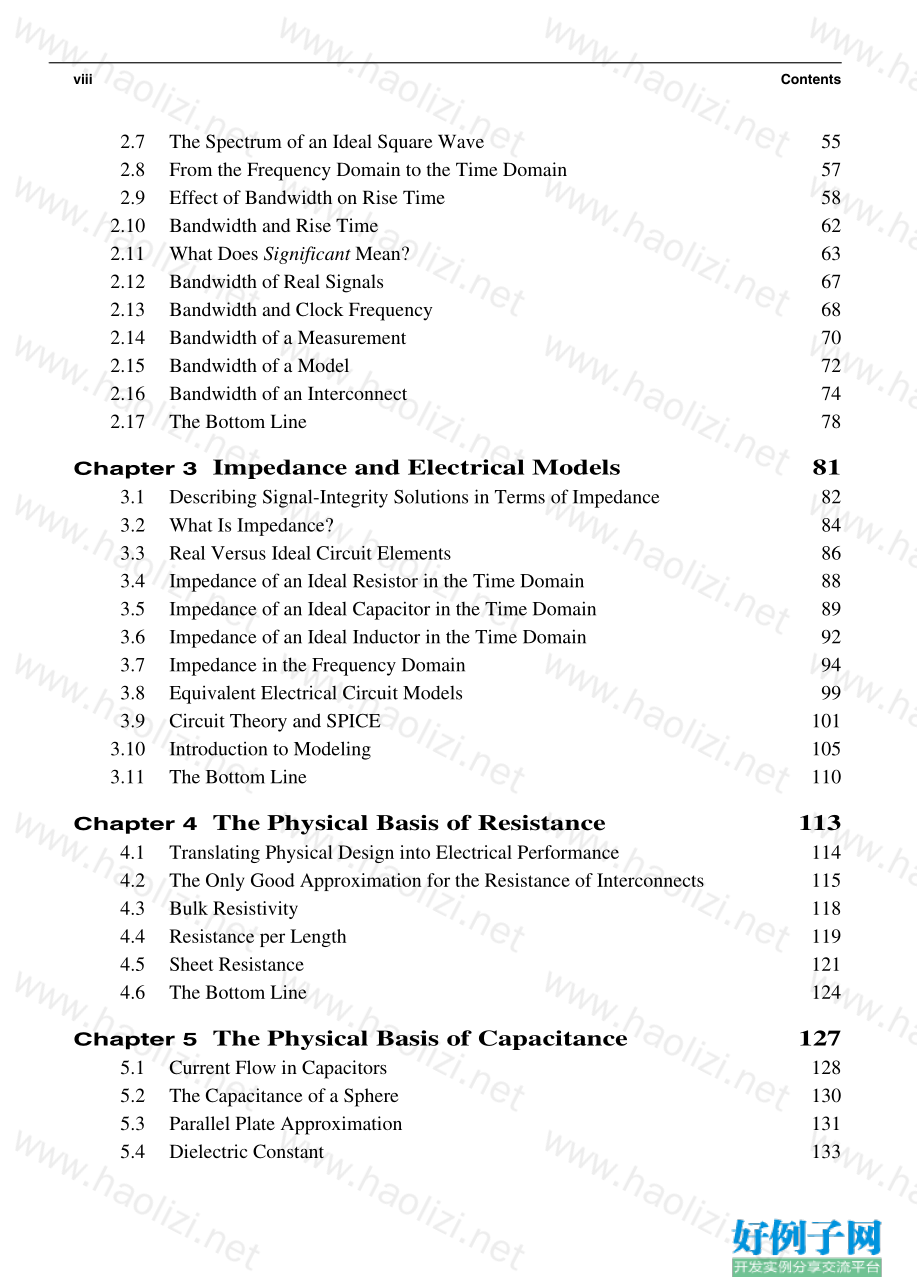
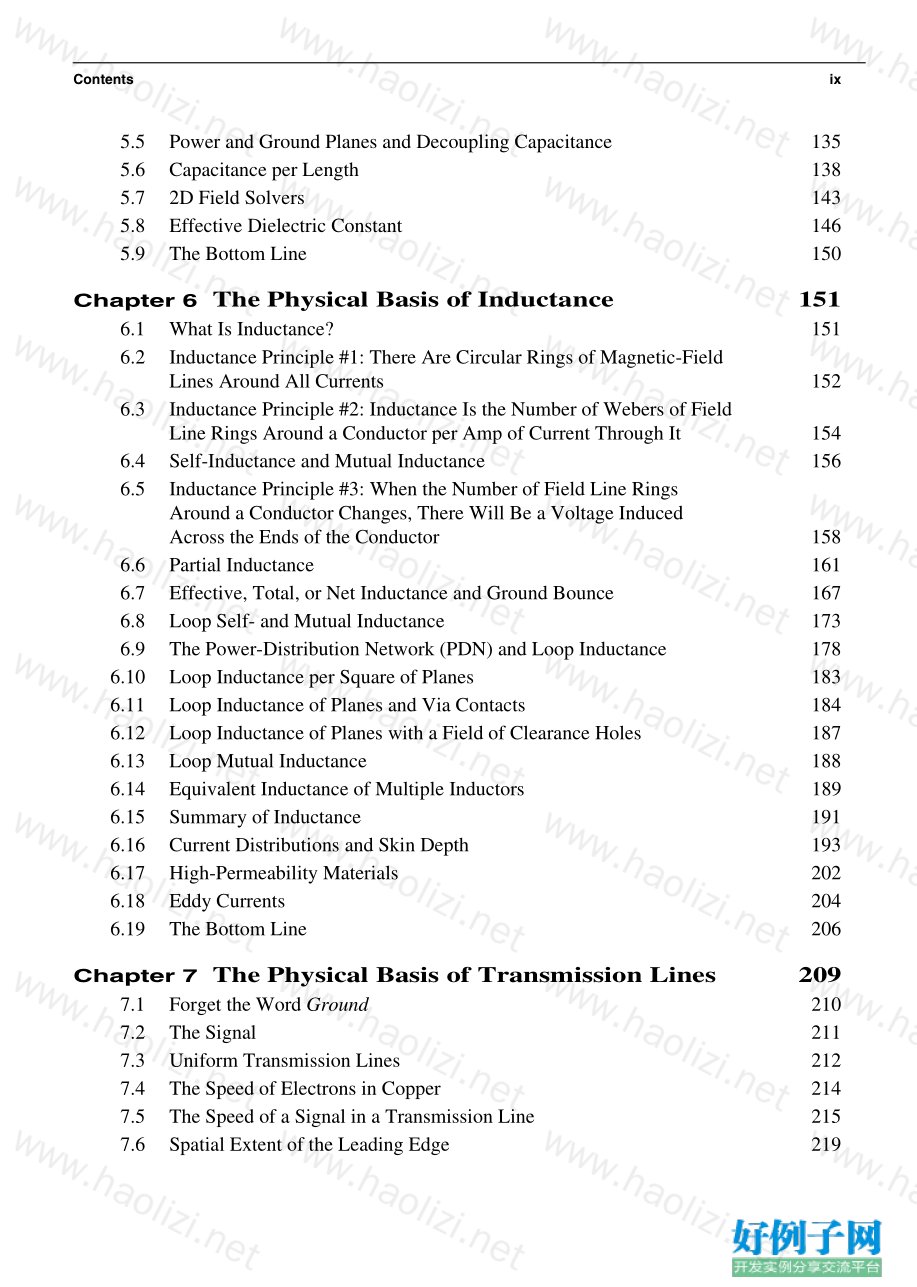
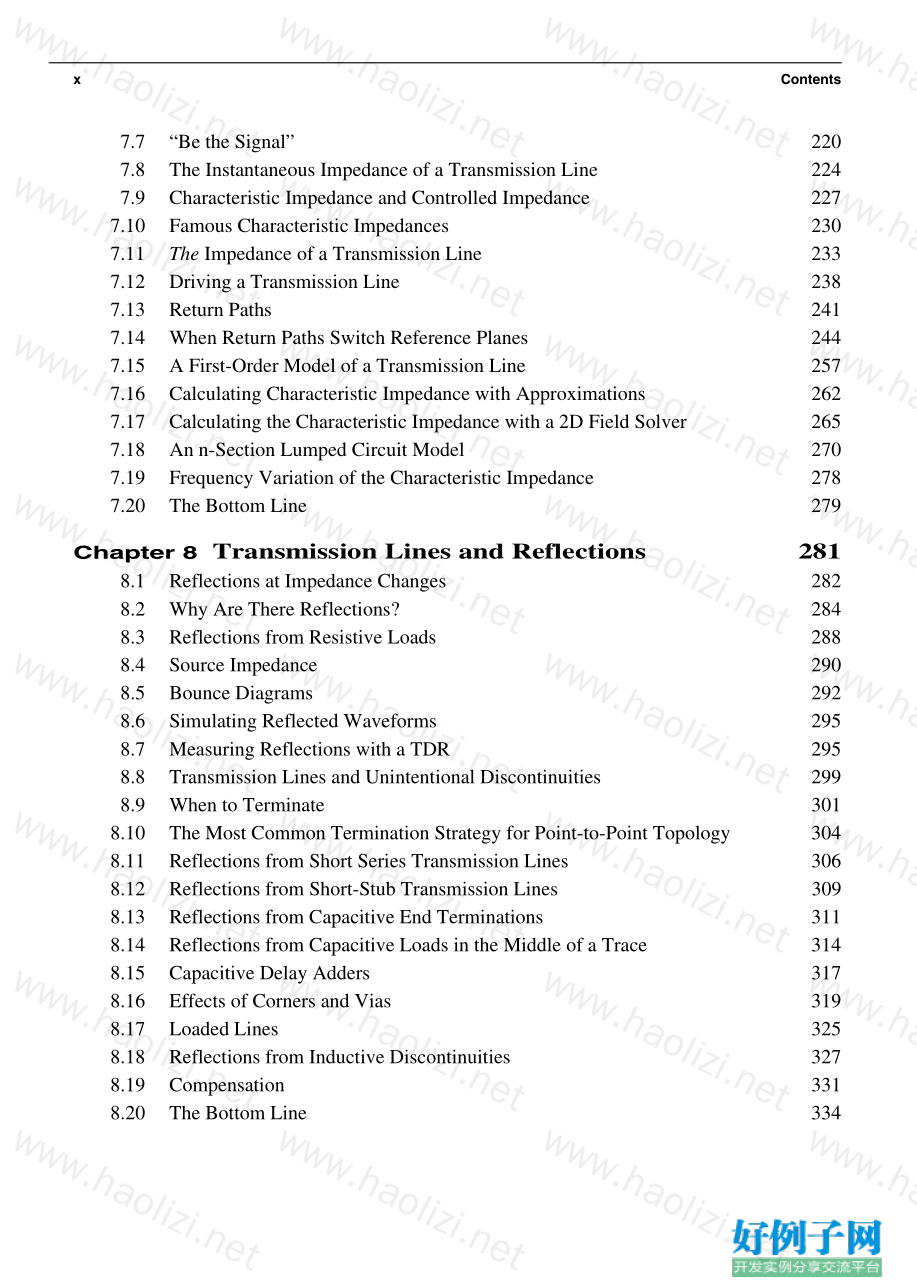
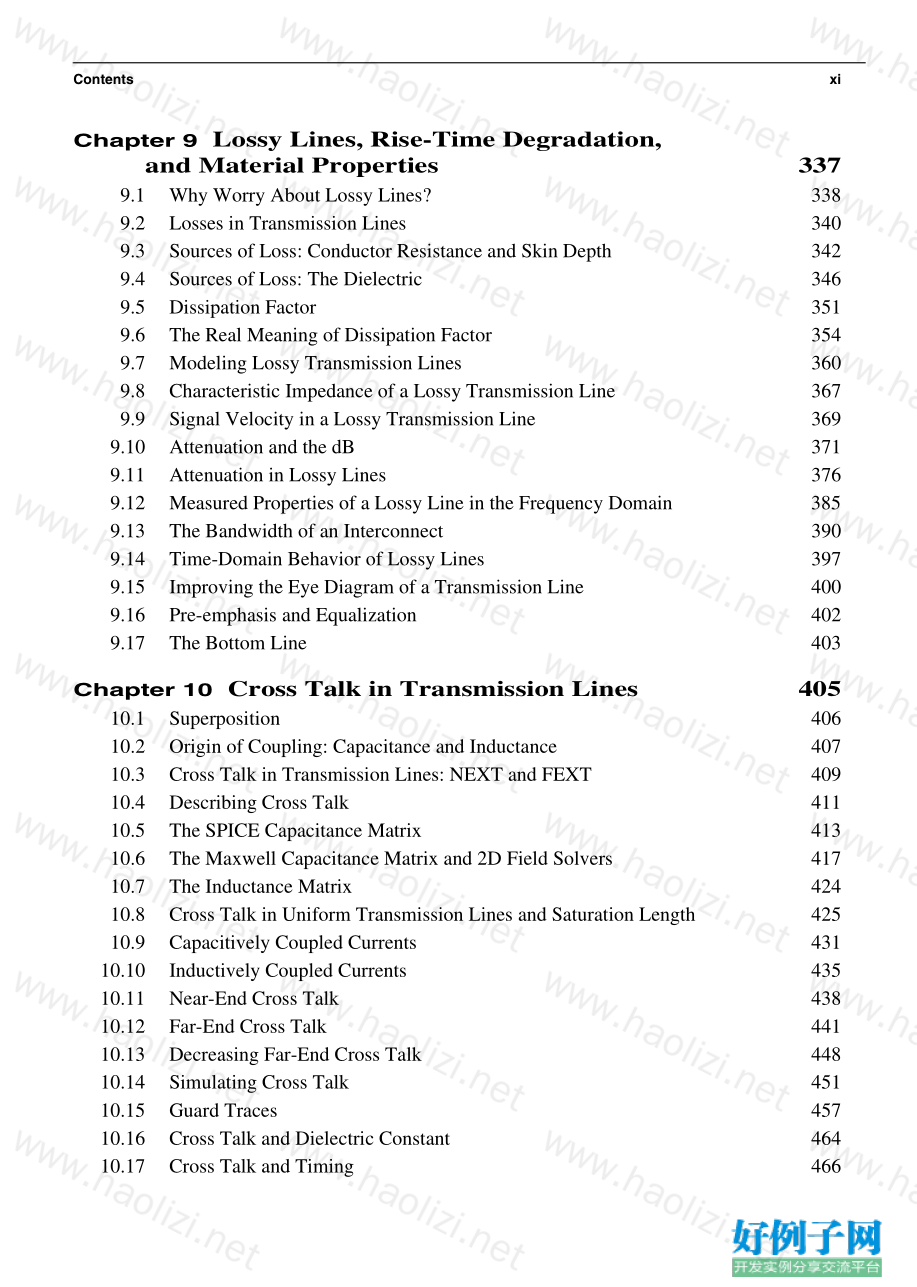
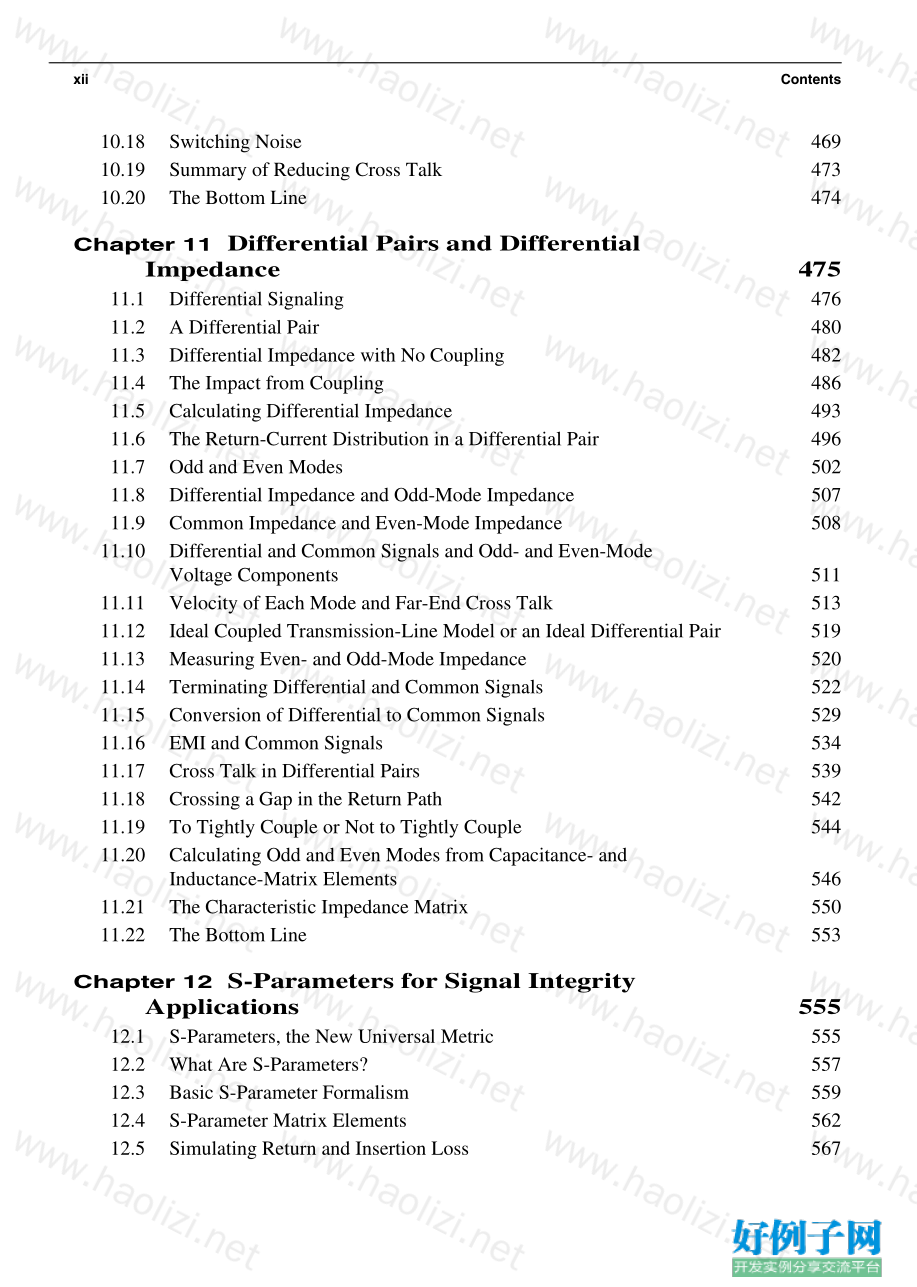

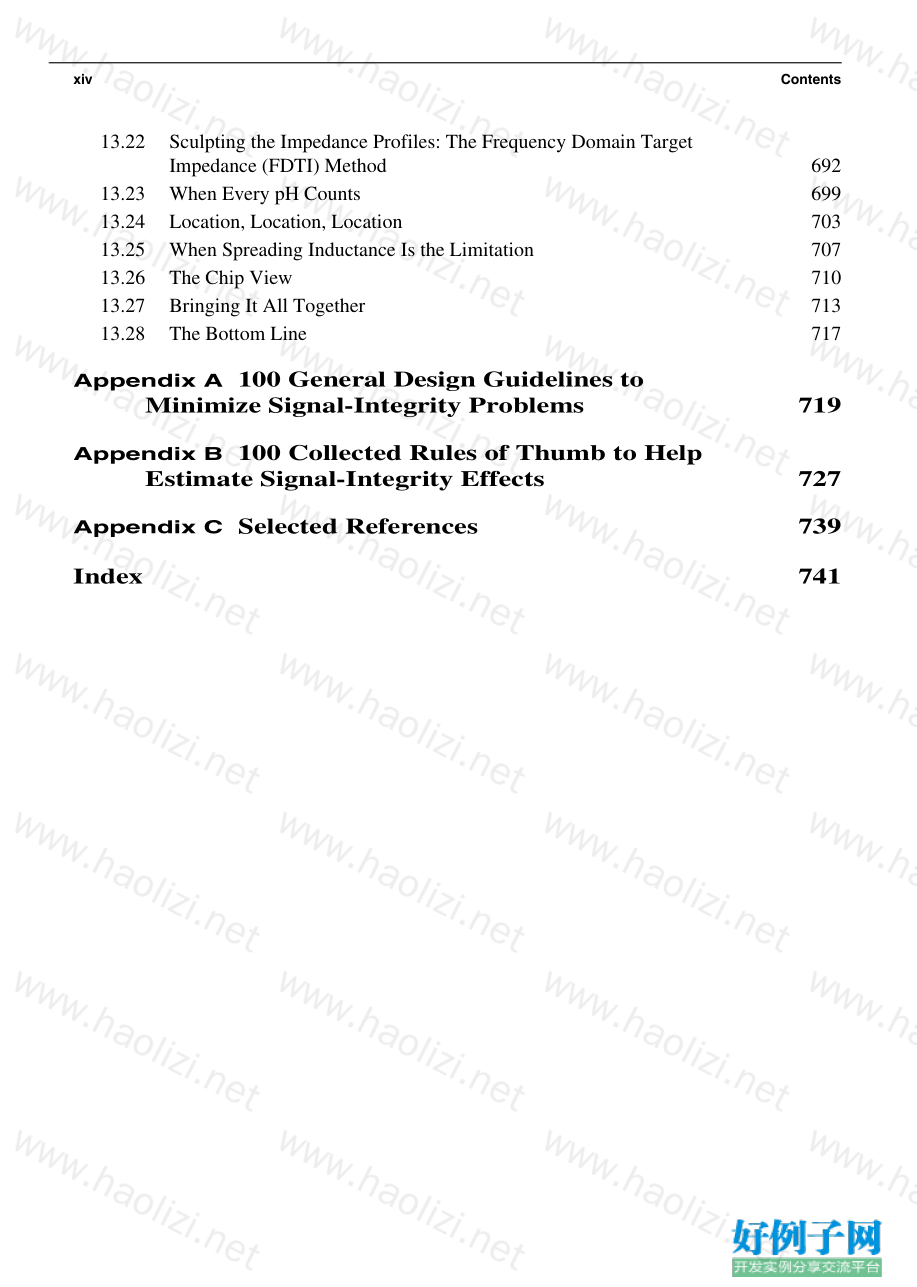
【核心代码】
C O N T E N T S
viii Contents
2.7 The Spectrum of an Ideal Square Wave 55
2.8 From the Frequency Domain to the Time Domain 57
2.9 Effect of Bandwidth on Rise Time 58
2.10 Bandwidth and Rise Time 62
2.11 What Does Significant Mean? 63
2.12 Bandwidth of Real Signals 67
2.13 Bandwidth and Clock Frequency 68
2.14 Bandwidth of a Measurement 70
2.15 Bandwidth of a Model 72
2.16 Bandwidth of an Interconnect 74
2.17 The Bottom Line 78
Chapter 3 Impedance and Electrical Models 81
3.1 Describing Signal-Integrity Solutions in Terms of Impedance 82
3.2 What Is Impedance? 84
3.3 Real Versus Ideal Circuit Elements 86
3.4 Impedance of an Ideal Resistor in the Time Domain 88
3.5 Impedance of an Ideal Capacitor in the Time Domain 89
3.6 Impedance of an Ideal Inductor in the Time Domain 92
3.7 Impedance in the Frequency Domain 94
3.8 Equivalent Electrical Circuit Models 99
3.9 Circuit Theory and SPICE 101
3.10 Introduction to Modeling 105
3.11 The Bottom Line 110
Chapter 4 The Physical Basis of Resistance 113
4.1 Translating Physical Design into Electrical Performance 114
4.2 The Only Good Approximation for the Resistance of Interconnects 115
4.3 Bulk Resistivity 118
4.4 Resistance per Length 119
4.5 Sheet Resistance 121
4.6 The Bottom Line 124
Chapter 5 The Physical Basis of Capacitance 127
5.1 Current Flow in Capacitors 128
5.2 The Capacitance of a Sphere 130
5.3 Parallel Plate Approximation 131
5.4 Dielectric Constant 133
Contents ix
5.5 Power and Ground Planes and Decoupling Capacitance 135
5.6 Capacitance per Length 138
5.7 2D Field Solvers 143
5.8 Effective Dielectric Constant 146
5.9 The Bottom Line 150
Chapter 6 The Physical Basis of Inductance 151
6.1 What Is Inductance? 151
6.2 Inductance Principle #1: There Are Circular Rings of Magnetic-Field
Lines Around All Currents 152
6.3 Inductance Principle #2: Inductance Is the Number of Webers of Field
Line Rings Around a Conductor per Amp of Current Through It 154
6.4 Self-Inductance and Mutual Inductance 156
6.5 Inductance Principle #3: When the Number of Field Line Rings
Around a Conductor Changes, There Will Be a Voltage Induced
Across the Ends of the Conductor 158
6.6 Partial Inductance 161
6.7 Effective, Total, or Net Inductance and Ground Bounce 167
6.8 Loop Self- and Mutual Inductance 173
6.9 The Power-Distribution Network (PDN) and Loop Inductance 178
6.10 Loop Inductance per Square of Planes 183
6.11 Loop Inductance of Planes and Via Contacts 184
6.12 Loop Inductance of Planes with a Field of Clearance Holes 187
6.13 Loop Mutual Inductance 188
6.14 Equivalent Inductance of Multiple Inductors 189
6.15 Summary of Inductance 191
6.16 Current Distributions and Skin Depth 193
6.17 High-Permeability Materials 202
6.18 Eddy Currents 204
6.19 The Bottom Line 206
Chapter 7 The Physical Basis of Transmission Lines 209
7.1 Forget the Word Ground 210
7.2 The Signal 211
7.3 Uniform Transmission Lines 212
7.4 The Speed of Electrons in Copper 214
7.5 The Speed of a Signal in a Transmission Line 215
7.6 Spatial Extent of the Leading Edge 219
x Contents
7.7 “Be the Signal” 220
7.8 The Instantaneous Impedance of a Transmission Line 224
7.9 Characteristic Impedance and Controlled Impedance 227
7.10 Famous Characteristic Impedances 230
7.11 The Impedance of a Transmission Line 233
7.12 Driving a Transmission Line 238
7.13 Return Paths 241
7.14 When Return Paths Switch Reference Planes 244
7.15 A First-Order Model of a Transmission Line 257
7.16 Calculating Characteristic Impedance with Approximations 262
7.17 Calculating the Characteristic Impedance with a 2D Field Solver 265
7.18 An n-Section Lumped Circuit Model 270
7.19 Frequency Variation of the Characteristic Impedance 278
7.20 The Bottom Line 279
Chapter 8 Transmission Lines and Reflections 281
8.1 Reflections at Impedance Changes 282
8.2 Why Are There Reflections? 284
8.3 Reflections from Resistive Loads 288
8.4 Source Impedance 290
8.5 Bounce Diagrams 292
8.6 Simulating Reflected Waveforms 295
8.7 Measuring Reflections with a TDR 295
8.8 Transmission Lines and Unintentional Discontinuities 299
8.9 When to Terminate 301
8.10 The Most Common Termination Strategy for Point-to-Point Topology 304
8.11 Reflections from Short Series Transmission Lines 306
8.12 Reflections from Short-Stub Transmission Lines 309
8.13 Reflections from Capacitive End Terminations 311
8.14 Reflections from Capacitive Loads in the Middle of a Trace 314
8.15 Capacitive Delay Adders 317
8.16 Effects of Corners and Vias 319
8.17 Loaded Lines 325
8.18 Reflections from Inductive Discontinuities 327
8.19 Compensation 331
8.20 The Bottom Line 334
Contents xi
Chapter 9 Lossy Lines, Rise-Time Degradation,
and Material Properties 337
9.1 Why Worry About Lossy Lines? 338
9.2 Losses in Transmission Lines 340
9.3 Sources of Loss: Conductor Resistance and Skin Depth 342
9.4 Sources of Loss: The Dielectric 346
9.5 Dissipation Factor 351
9.6 The Real Meaning of Dissipation Factor 354
9.7 Modeling Lossy Transmission Lines 360
9.8 Characteristic Impedance of a Lossy Transmission Line 367
9.9 Signal Velocity in a Lossy Transmission Line 369
9.10 Attenuation and the dB 371
9.11 Attenuation in Lossy Lines 376
9.12 Measured Properties of a Lossy Line in the Frequency Domain 385
9.13 The Bandwidth of an Interconnect 390
9.14 Time-Domain Behavior of Lossy Lines 397
9.15 Improving the Eye Diagram of a Transmission Line 400
9.16 Pre-emphasis and Equalization 402
9.17 The Bottom Line 403
Chapter 10 Cross Talk in Transmission Lines 405
10.1 Superposition 406
10.2 Origin of Coupling: Capacitance and Inductance 407
10.3 Cross Talk in Transmission Lines: NEXT and FEXT 409
10.4 Describing Cross Talk 411
10.5 The SPICE Capacitance Matrix 413
10.6 The Maxwell Capacitance Matrix and 2D Field Solvers 417
10.7 The Inductance Matrix 424
10.8 Cross Talk in Uniform Transmission Lines and Saturation Length 425
10.9 Capacitively Coupled Currents 431
10.10 Inductively Coupled Currents 435
10.11 Near-End Cross Talk 438
10.12 Far-End Cross Talk 441
10.13 Decreasing Far-End Cross Talk 448
10.14 Simulating Cross Talk 451
10.15 Guard Traces 457
10.16 Cross Talk and Dielectric Constant 464
10.17 Cross Talk and Timing 466
xii Contents
10.18 Switching Noise 469
10.19 Summary of Reducing Cross Talk 473
10.20 The Bottom Line 474
Chapter 11 Differential Pairs and Differential
Impedance 475
11.1 Differential Signaling 476
11.2 A Differential Pair 480
11.3 Differential Impedance with No Coupling 482
11.4 The Impact from Coupling 486
11.5 Calculating Differential Impedance 493
11.6 The Return-Current Distribution in a Differential Pair 496
11.7 Odd and Even Modes 502
11.8 Differential Impedance and Odd-Mode Impedance 507
11.9 Common Impedance and Even-Mode Impedance 508
11.10 Differential and Common Signals and Odd- and Even-Mode
Voltage Components 511
11.11 Velocity of Each Mode and Far-End Cross Talk 513
11.12 Ideal Coupled Transmission-Line Model or an Ideal Differential Pair 519
11.13 Measuring Even- and Odd-Mode Impedance 520
11.14 Terminating Differential and Common Signals 522
11.15 Conversion of Differential to Common Signals 529
11.16 EMI and Common Signals 534
11.17 Cross Talk in Differential Pairs 539
11.18 Crossing a Gap in the Return Path 542
11.19 To Tightly Couple or Not to Tightly Couple 544
11.20 Calculating Odd and Even Modes from Capacitance- and
Inductance-Matrix Elements 546
11.21 The Characteristic Impedance Matrix 550
11.22 The Bottom Line 553
Chapter 12 S-Parameters for Signal Integrity
Applications 555
12.1 S-Parameters, the New Universal Metric 555
12.2 What Are S-Parameters? 557
12.3 Basic S-Parameter Formalism 559
12.4 S-Parameter Matrix Elements 562
12.5 Simulating Return and Insertion Loss 567
Contents xiii
12.6 A Transparent Interconnect 570
12.7 Changing the Port Impedance 573
12.8 The Phase of S21 for a Uniform 50-Ohm Transmission Line 574
12.9 The Magnitude of S21 for a Uniform Transmission Line 577
12.10 Coupling to Other Transmission Lines 582
12.11 Insertion Loss for Non-50-Ohm Transmission Lines 589
12.12 Data-Mining S-Parameters 594
12.13 Single-Ended and Differential S-Parameters 596
12.14 Differential Insertion Loss 601
12.15 The Mode Conversion Terms 605
12.16 Converting to Mixed-Mode S-Parameters 607
12.17 Time and Frequency Domains 609
12.18 The Bottom Line 613
Chapter 13 The Power Distribution Network (PDN) 615
13.1 The Problem 615
13.2 The Root Cause 618
13.3 The Most Important Design Guidelines for the PDN 620
13.4 Establishing the Target Impedance Is Hard 621
13.5 Every Product Has a Unique PDN Requirement 629
13.6 Engineering the PDN 631
13.7 The VRM 633
13.8 Simulating Impedance with SPICE 635
13.9 On-die Capacitance 637
13.10 The Package Barrier 639
13.11 The PDN with No Decoupling Capacitors 644
13.12 The MLCC Capacitor 646
13.13 The Equivalent Series Inductance 650
13.14 Approximating Loop Inductance 652
13.15 Optimizing the Mounting of Capacitors 661
13.16 Combining Capacitors in Parallel 667
13.17 Engineering a Reduced Parallel Resonant Peak by Adding
More Capacitors 673
13.18 Selecting Capacitor Values 675
13.19 Estimating the Number of Capacitors Needed 681
13.20 How Much Does a nH Cost? 683
13.21 Quantity or Specific Values? 687
xiv Contents
13.22 Sculpting the Impedance Profiles: The Frequency Domain Target
Impedance (FDTI) Method 692
13.23 When Every pH Counts 699
13.24 Location, Location, Location 703
13.25 When Spreading Inductance Is the Limitation 707
13.26 The Chip View 710
13.27 Bringing It All Together 713
13.28 The Bottom Line 717
Appendix A 100 General Design Guidelines to
Minimize Signal-Integrity Problems 719
Appendix B 100 Collected Rules of Thumb to Help
Estimate Signal-Integrity Effects 727
Appendix C Selected References 739
Index 741
Signal and Power Integrity-Simplified Second Edition(Eric Bogatin)
小贴士
感谢您为本站写下的评论,您的评论对其它用户来说具有重要的参考价值,所以请认真填写。
- 类似“顶”、“沙发”之类没有营养的文字,对勤劳贡献的楼主来说是令人沮丧的反馈信息。
- 相信您也不想看到一排文字/表情墙,所以请不要反馈意义不大的重复字符,也请尽量不要纯表情的回复。
- 提问之前请再仔细看一遍楼主的说明,或许是您遗漏了。
- 请勿到处挖坑绊人、招贴广告。既占空间让人厌烦,又没人会搭理,于人于己都无利。
关于好例子网
本站旨在为广大IT学习爱好者提供一个非营利性互相学习交流分享平台。本站所有资源都可以被免费获取学习研究。本站资源来自网友分享,对搜索内容的合法性不具有预见性、识别性、控制性,仅供学习研究,请务必在下载后24小时内给予删除,不得用于其他任何用途,否则后果自负。基于互联网的特殊性,平台无法对用户传输的作品、信息、内容的权属或合法性、安全性、合规性、真实性、科学性、完整权、有效性等进行实质审查;无论平台是否已进行审查,用户均应自行承担因其传输的作品、信息、内容而可能或已经产生的侵权或权属纠纷等法律责任。本站所有资源不代表本站的观点或立场,基于网友分享,根据中国法律《信息网络传播权保护条例》第二十二与二十三条之规定,若资源存在侵权或相关问题请联系本站客服人员,点此联系我们。关于更多版权及免责申明参见 版权及免责申明



网友评论
我要评论